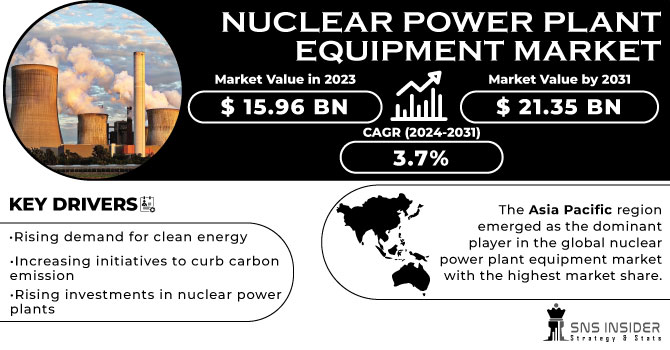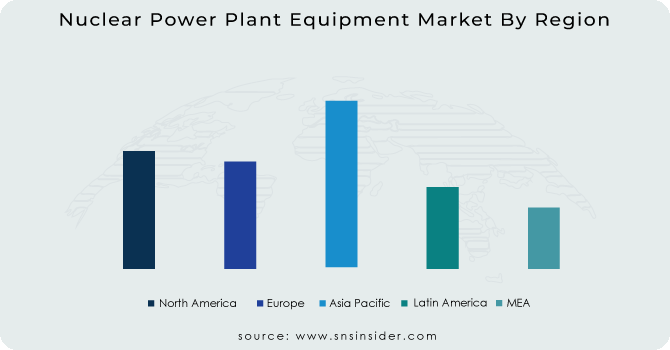Nuclear Power Plant Equipment Market Report Scope & Overview:
The Nuclear Power Plant Equipment Market size was valued at USD 15.96 billion in 2023 and is expected to grow to USD 21.35 billion by 2031 with a growing CAGR of 3.7 % over the forecast period of 2024-2031.
Nuclear power plant equipment is essential for the safe and efficient operation of nuclear power plants. This equipment includes various components such as reactors, turbines, generators, cooling systems, and control systems. The reactors are the heart of the nuclear power plant, where nuclear reactions take place to produce heat.

To Get More Information on Nuclear Power Plant Equipment Market - Request Sample Report
The heat generated is then used to produce steam, which drives the turbines. The turbines, in turn, drive the generators to produce electricity. Cooling systems are crucial to maintain the temperature of the reactors and prevent overheating. Control systems are used to monitor and regulate the various processes in the power plant to ensure safe and efficient operation. It is imperative that nuclear power plant equipment is designed, manufactured, and maintained to the highest standards to ensure the safety of the workers and the public. Regular inspections and maintenance are necessary to identify and address any potential issues before they become a safety hazard.
The Nuclear Power Plant Equipment Market is a crucial sector in the energy industry. This market is expected to grow significantly in the coming years, driven by the increasing demand for clean and reliable energy sources. The growth of the nuclear power plant equipment market is driven by several factors, including the increasing demand for electricity, the need for clean energy sources, and the growing concerns over climate change. Nuclear power plants are a reliable and efficient source of energy that can help reduce greenhouse gas emissions and meet the growing electricity demand.
Market Dynamics:
Drivers
-
Rising demand for clean energy
-
Increasing initiatives to curb carbon emission
-
Rising investments in nuclear power plants
-
Increasing demand for sustainable and clean energy sources
The growing demand for clean and sustainable energy sources is the primary driving force behind the nuclear power plant equipment market. This trend is fueled by the need to reduce carbon emissions and mitigate the impact of climate change. Nuclear power plants offer a reliable and efficient source of energy that can meet the increasing demand for electricity while reducing greenhouse gas emissions. Furthermore, the nuclear power industry has significantly improved safety and reduced the risk of accidents. Advanced technologies and rigorous safety protocols have been implemented to ensure that nuclear power plants operate safely and efficiently. As a result, nuclear power is becoming an increasingly attractive option for countries looking to diversify their energy mix and reduce their reliance on fossil fuels.
Restrain
-
High costs associated with nuclear power plants
Opportunities
-
Increasing demand for nuclear energy in emerging nations
-
Growing focus on nuclear fusion as a potential energy source
-
Development of small modular reactors
The development of small modular reactors presents a significant opportunity for the nuclear power plant equipment market. This emerging technology offers a more flexible and cost-effective solution for generating nuclear power. Small modular reactors are designed to be smaller and more compact than traditional nuclear reactors, making them easier to transport and install. They also have the potential to be more efficient and safer, with advanced safety features and automated systems. As a result, the demand for equipment and components for small modular reactors is expected to increase in the coming years. This includes everything from reactor vessels and control systems to fuel rods and cooling systems. Investing in the development and production of small modular reactors and their associated equipment could lead to significant growth opportunities for companies in the nuclear power industry. It could also help to meet the growing demand for clean and reliable energy sources while reducing greenhouse gas emissions and promoting sustainable development.
Challenges
-
Regulatory challenges that exist in many countries
-
Increasing safety concerns associated with nuclear energy
Impact of Russia-Ukraine War:
The Russia and Ukraine war affected the nuclear power plant equipment market significantly. The nuclear power plant projects have been significantly hampered during this war. The Russian invasion of Ukraine has triggered the cancellation of planned Russian-built nuclear power plants in Finland, Jordan, and Slovakia. The war has caused disruptions in the supply chain of nuclear power plant equipment, leading to delays in the construction and maintenance of these facilities. According to the World Nuclear Association, Ukraine has 15 operable nuclear reactors at 4 plants that generate about half of its electricity. The political tensions between the two countries have decreased demand for nuclear power plant equipment in Ukraine, which was once a significant market for such products.
Impact of Recession:
The downturn in the global economy has led to a decrease in demand for nuclear power, resulting in a decline in the market for nuclear power plant equipment. This decline in demand has been particularly evident in developed countries, where the economic recession has led to a decrease in energy consumption. As a result, many nuclear power plants have been forced to reduce their output leading to a decrease in demand for equipment. The more detailed insights are comprised in the final report.
Key Market Segmentation
By Reactor Type
-
Pressurized Heavy Water Reactor (PHWR)
-
Boiling Water Reactor (BWR)
-
Pressurized Water Reactor (PWR)
-
Gas Cooled Reactor (GCR)
-
Light Water Graphite Reactor (LWGR)
-
Others
By Equipment Type
-
Auxiliary Equipment
-
Island Equipment
Regional Analysis
In 2022, the Asia Pacific region emerged as the dominant player in the global nuclear power plant equipment market with the highest market share. One of the main reasons for the Asia Pacific region's dominance in this market is the presence of a large number of nuclear power units. Asia currently boasts approximately one-fourth of the world's operational nuclear power units. As of June 2021, 6 Asian markets and regions, namely Japan, South Korea, mainland China, Taiwan, India, and Pakistan, are operating a total of 114 reactors, generating a staggering 97.4 GW of power, with over half of these reactors were constructed before 2011, and around 30-35 are currently under construction, with firm plans to build an additional 40-50. Moreover, As the region's population and economy continue to grow, so does its need for reliable and sustainable sources of energy. Nuclear power is seen as a viable option to meet this demand, and many countries in the region have invested heavily in nuclear power plant infrastructure. Furthermore, the Asia Pacific region is home to several established nuclear power plant equipment manufacturers, including Toshiba, Hitachi, and Mitsubishi Heavy Industries. These companies have a long history of producing high-quality equipment and have established strong relationships with customers in the region.
North America is expected to grow with a significant CAGR during the forecast period from 2023-2030. This growth is mainly due to the region’s long history of nuclear power generation, with the United States being one of the pioneers in this field. This has given North American companies a significant advantage in terms of experience and expertise in designing and manufacturing nuclear power plant equipment.

Do You Need any Customization Research on Nuclear Power Plant Equipment Market - Enquire Now
REGIONAL COVERAGE:
-
North America
-
USA
-
Canada
-
Mexico
-
-
Europe
-
Germany
-
UK
-
France
-
Italy
-
Spain
-
The Netherlands
-
Rest of Europe
-
-
Asia-Pacific
-
Japan
-
south Korea
-
China
-
India
-
Australia
-
Rest of Asia-Pacific
-
-
The Middle East & Africa
-
Israel
-
UAE
-
South Africa
-
Rest of the Middle East & Africa
-
-
Latin America
-
Brazil
-
Argentina
-
Rest of Latin America
-
Key Players
The major players are BWX Technologies, Inc, Westinghouse Electric Corporation, Hitachi-GE Nuclear Energy Ltd, Mitsubishi Heavy Industries, General Electric, NuScale Power LLC, Larsen & Toubro Limited, Toshiba, Doosan Corporation, Shanghai Electric Group Co., Ltd., and other key players mentioned in the final report.
BWX Technologies Inc-Company Financial Analysis

Recent Development:
-
In Oct 2022, Westinghouse Electric was awarded a contract to construct Poland's first nuclear facility. This decision comes as the country aims to transition away from coal and decrease its carbon emissions.
-
In Oct 2022, L&T commenced construction on another nuclear facility for the Nuclear Power Corporation of India Limited (NPCIL).
-
In June 2022, BWX Technologies was granted a contract by the U.S. Department of Defense (DoD) Strategic Capabilities Office (SCO) to construct the first advanced nuclear microreactor in the United States.
| Report Attributes | Details |
| Market Size in 2023 | US$ 15.96 Bn |
| Market Size by 2031 | US$ 21.35 Bn |
| CAGR | CAGR of 3.7 % From 2024 to 2031 |
| Base Year | 2023 |
| Forecast Period | 2024-2031 |
| Historical Data | 2020-2022 |
| Report Scope & Coverage | Market Size, Segments Analysis, Competitive Landscape, Regional Analysis, DROC & SWOT Analysis, Forecast Outlook |
| Key Segments | • By Reactor Type (Pressurized Heavy Water Reactor (PHWR), Boiling Water Reactor (BWR), Pressurized Water Reactor (PWR), Gas Cooled Reactor (GCR), Light Water Graphite Reactor (LWGR), and Others) • By Equipment Type (Auxiliary Equipment and Island Equipment) |
| Regional Analysis/Coverage | North America (USA, Canada, Mexico), Europe (Germany, UK, France, Italy, Spain, Netherlands, Rest of Europe), Asia-Pacific (Japan, South Korea, China, India, Australia, Rest of Asia-Pacific), The Middle East & Africa (Israel, UAE, South Africa, Rest of Middle East & Africa), Latin America (Brazil, Argentina, Rest of Latin America) |
| Company Profiles | BWX Technologies, Inc, Westinghouse Electric Corporation, Hitachi-GE Nuclear Energy Ltd, Mitsubishi Heavy Industries, General Electric, NuScale Power LLC, Larsen & Toubro Limited, Toshiba, Doosan Corporation, Shanghai Electric Group Co., Ltd., and other |
| Key Drivers | • Rising demand for clean energy • Increasing initiatives to curb carbon emission |
| Market Opportunities | • Increasing demand for nuclear energy in emerging nations • Growing focus on nuclear fusion as a potential energy source • Development of small modular reactors |

